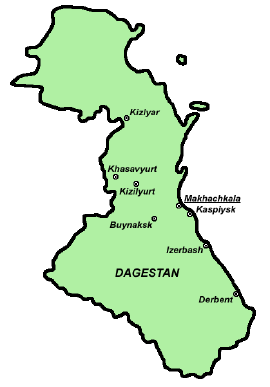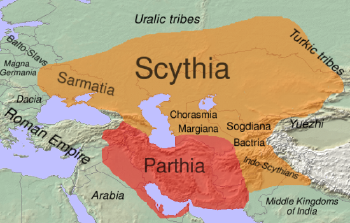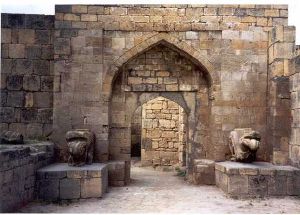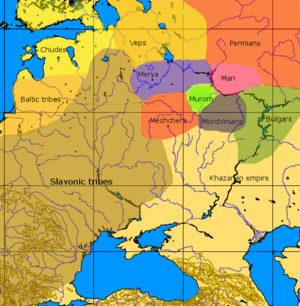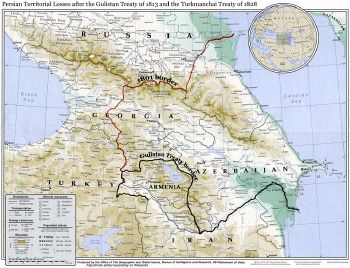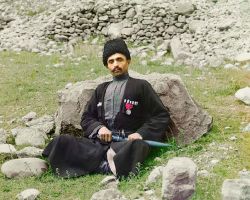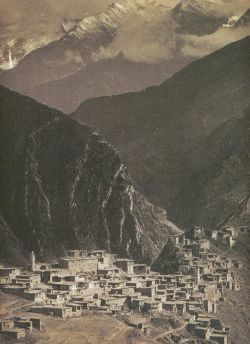Difference between revisions of "Dagestan" - New World Encyclopedia
Mike Butler (talk | contribs) |
Mike Butler (talk | contribs) |
||
| Line 116: | Line 116: | ||
===Avar Khanate=== | ===Avar Khanate=== | ||
| − | The Avar Khanate was a long-lived [[Muslim]] state which controlled Central [[Dagestan]] from the early thirteenth century to the nineteenth century. Following the downfall of the Christian kingdom of [[Sarir]] in the early 12th century, the [[Caucasian Avars]] underwent a process of peaceful [[Islam]]ization. | + | The Avar Khanate was a long-lived [[Muslim]] state which controlled Central [[Dagestan]] from the early thirteenth century to the nineteenth century. Following the downfall of the Christian kingdom of [[Sarir]] in the early 12th century, the [[Caucasian Avars]], who had migrated there from [[Khwarezm]], underwent a process of peaceful [[Islam]]ization. |
Military tensions escalated in 1222, when the region was invaded by the pagan [[Mongols]] under [[Subutai]]. Although the [[Avar]]s pledged their support to [[Muhammad II of Khwarezm]] in his struggle against the Mongols, there is no documentation for the Mongol invasion of the Avar lands. As historical clues are so scarce, it is probably fruitless to speculate whether the Avars were the agents of the Mongol influence in the Caucasus and whether they were entrusted with the task of levying tribute for the khan. | Military tensions escalated in 1222, when the region was invaded by the pagan [[Mongols]] under [[Subutai]]. Although the [[Avar]]s pledged their support to [[Muhammad II of Khwarezm]] in his struggle against the Mongols, there is no documentation for the Mongol invasion of the Avar lands. As historical clues are so scarce, it is probably fruitless to speculate whether the Avars were the agents of the Mongol influence in the Caucasus and whether they were entrusted with the task of levying tribute for the khan. | ||
| Line 122: | Line 122: | ||
The [[Khanate of Avaristan]] survived [[Tamerlane]]'s raid in 1389. | The [[Khanate of Avaristan]] survived [[Tamerlane]]'s raid in 1389. | ||
| − | + | As the Mongol authority gradually eroded, new centres of power emerged in Kaitagi and [[Tarki]]. In the sixteenth and seventeenth centuries, legal traditions were codified, mountainous communities (''djamaats'') obtained a considerable degree of autonomy, while the [[Kumyk]] potentates (''[[shamkhal (title)|shamhals]]'') asked for the Tsar's protection. | |
| − | In the eighteenth century, the steady weakening of Tarki fostered the ambitions of the Avar khans, whose greatest coup was the defeat of the 100,000-strong army of [[Nadir Shah]] in September 1741. | + | In the eighteenth century, the steady weakening of Tarki fostered the ambitions of the Avar khans, whose greatest coup was the defeat of the 100,000-strong army of [[Nadir Shah]] of Persia in September 1741. Avar sovereigns managed to expand their territory at the expense of free communities in Dagestan and [[Chechnya]]. |
| − | + | The reign of Umma-Khan (1774-1801) marked the zenith of the Avar ascendancy in the Caucasus. Among the potentates who paid tribute to Umma-Khan were the rulers of [[Derbent]], [[Shaki]], [[Quba]], [[Baku]], [[Shirvan]], [[Akhaltsikhe]], and even [[Erekle II]] of [[Georgia (country)|Georgia]]. | |
===Russian protection=== | ===Russian protection=== | ||
| − | + | [[Image:Gulistan-Treaty.jpg|thumb|350px|[[imperial Russia|Russia]]-[[Persian Empire|Persia]] borders before and after the treaty.]] | |
| + | Russians intensified their hold in the region in the eighteenth century, when [[Peter the Great]] annexed maritime Dagestan in the course of the [[First Russo-Persian War]] (1722-23). Although the territories were returned to Persia in 1735, the Persian Expedition of 1796 resulted in the Russian capture of Derbent in 1796. | ||
| + | |||
| + | In 1803, within two years after Umma-Khan's death, the khanate voluntarily submitted to Russian authority, but it took Persia a decade to recognize all of Dagestan as the Russian possession (Treaty of Gulistan in 1813). Yet the Russian administration disappointed and embittered freedom-loving highlanders. The institution of heavy taxation, coupled with the expropriation of estates and the construction of fortresses, electrified the Avar population into rising under the aegis of the radical Muslim [[Imamate of Dagestan|Imamate]], led by [[Ghazi Mohammed]] (1828-32), [[Gamzat-bek]] (1832-34) and [[Shamil]] (1834-59). | ||
| + | |||
| + | ===Caucasian War=== | ||
| + | The Caucasian War of 1718–1864, was a series of military actions waged by the [[Russian Empire]] against a number of territories and tribal groups in [[Caucasia]] including [[Chechnya]], [[Dagestan]] and the [[Adyghe people|Adyghe]] ([[Circassians]]) as Russia sought to expand southward. This [[Caucasian War]] raged until 1864, when Shamil was captured, when the Avar Khanate was abolished, and the [[Avar District]] was instituted instead. | ||
| + | |||
| + | |||
| + | |||
| − | |||
| − | |||
[[Image:Prokudin-Gorskii-43.jpg|thumb|250px|right|Dagestani man, photographed by [[Sergei Mikhailovich Prokudin-Gorskii|Prokudin-Gorskii]], circa 1907 to 1915.]] | [[Image:Prokudin-Gorskii-43.jpg|thumb|250px|right|Dagestani man, photographed by [[Sergei Mikhailovich Prokudin-Gorskii|Prokudin-Gorskii]], circa 1907 to 1915.]] | ||
| − | + | ||
Dagestan and Chechnya profited from the [[Russo-Turkish War, 1877-1878]], to rise against [[Imperial Russia]] for the last time. During the Russian Civil War, the region became part of the short-lived [[Mountainous Republic of the Northern Caucasus|Republic of the Mountaineers of the North Caucasus]]. After more than three years of fighting [[White movement]] reactionaries and local [[nationalist]]s, the Dagestan [[ASSR]] was proclaimed on [[20 January]] [[1921]]. Nevertheless, [[Joseph Stalin|Stalin]]'s [[industrialization]] largely bypassed Dagestan and the economy stagnated, making the republic the poorest region in Russia. | Dagestan and Chechnya profited from the [[Russo-Turkish War, 1877-1878]], to rise against [[Imperial Russia]] for the last time. During the Russian Civil War, the region became part of the short-lived [[Mountainous Republic of the Northern Caucasus|Republic of the Mountaineers of the North Caucasus]]. After more than three years of fighting [[White movement]] reactionaries and local [[nationalist]]s, the Dagestan [[ASSR]] was proclaimed on [[20 January]] [[1921]]. Nevertheless, [[Joseph Stalin|Stalin]]'s [[industrialization]] largely bypassed Dagestan and the economy stagnated, making the republic the poorest region in Russia. | ||
Revision as of 21:30, 17 August 2007
| Republic of Dagestan (English) Республика Дагестан (Russian) | |
|---|---|
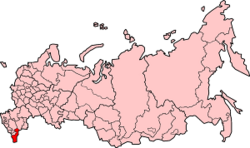 Location of the Republic of Dagestan in Russia | |
| Coat of Arms | Flag |
 Coat of arms of Dagestan |
 Flag of Dagestan |
| Anthem: National Anthem of the Republic of Dagestan | |
| Capital | Makhachkala |
| Established | January 20 1921 |
| Political status Federal district Economic region |
Republic Southern North Caucasus |
| Code | 05 |
| Area | |
| Area - Rank |
50,300 km² 52nd |
| Population (as of the 2021 Census) | |
| Population - Rank - Density - Urban - Rural |
2,576,531 inhabitants 22nd 51.2 inhab. / km² 42.8% 57.2% |
| Official languages | Russian, languages of the peoples of Dagestan |
| Government | |
| President | Mukhu Aliyev |
| Chairman of the Government | Shamil Zaynalov |
| Legislative body | People's Assembly |
| Constitution | Constitution of the Republic of Dagestan |
The Republic of Dagestan IPA: [dæɡɪˈstɑːn (IntEng), ˈdeɪɡəstæn (AmEng)] (Russian: Респу́блика Дагеста́н; Avar: Дагъистанлъул ДжумхIурият, Daɣistanłul Džumħuriyat), older spelling Daghestan, is a federal subject of the Russian Federation (a republic).
The republic is situated on the eastern end of the North Caucasus mountains along the western shore of the Caspian Sea. It is the southernmost part of Russia.
It is the largest republic of Russia in the North Caucasus, both in area and population.
The word Daghestan or Daghistan means "country of mountains", it is derived from the Turkic word dağ meaning mountain and Persian suffix -stan meaning "land of". The spelling Dagestan is a transliteration of the Russian name and is rather modern.
The republic's name in Persian and Arabic is داغستان.
Geography
Dagestan borders the Republic of Kalmykia to the north, the Chechen Republic to the west, Stavropol Krai to the northwest, Azerbaijan to the south, Georgia to the south-west, and the Caspian Sea to the east.
The land area is 19,420 square miles (50,300 km²), or about the size of Slovakia or the combined size of Massachusetts and Vermont in the United States.
Dagestan comprises five geographical regions. The first region, which takes up the southern half of the republic, consists of the Caucasus Mountains, the crest of which marks Dagestan's southern border. The highest point of the territory is located here, at Mount Bazar Duzu, which is 14,652 feet (4466 meters) above sea level. To the north of the mmain mountain ranges is a triangle of rugged mountains known as the Dagestan Interior Highland.
The second region, to the north of the mountains, is a zone of foreland hills, about 12 to 25 miles (19km to 40km) wide and rising to 2000–3000 feet (600–900 meters). The third region is a narrow coastal plain between the mountains and the Caspian Sea. The fourth area is a continuation of the coastal plain northward.
The fifth region is a rolling, sandy plain called the Nogay steppe, as far as the Kuma River, which forms the republic's northern boundary.
The climate is hot and dry in the summer but the winters are hard in the mountain areas. The average January temperature in the lowland is 25.5°F (-3.6°C), while the average July temperature is about 74.3°F (23.5°C). Rainfall in the interior mountainous areas averages 20–30 inches (510–760mm) annually, while rainfall in hot and dry north is with only 8–10 inches (200–250mm).
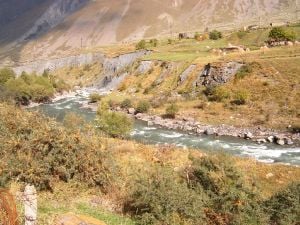
There are over 1800 rivers in the republic. The Terek is a major river in the Northern Caucasus. It rises in Georgia near the juncture of the The Greater Caucasus Mountain Range and the Khokh Range, then flows north through North Ossetia and the city of Vladikavkaz, through Chechnya and Dagestan before dividing into two branches which empty into the Caspian Sea. Below the city of Kizlyar it forms a swampy river delta around 60 miles (100km) wide. The river is a key natural asset in the region, being used for irrigation and hydroelectric power in its upper reaches. Other major rivers include the Sulak River, and Samur River.
Large areas of the southern mountains are devoid of vegetation. The foreland hills have dense oak, beech, hornbeam, maple, poplar, and black alder, with a grass steppe vegetation on the lower slopes. Vegetation in the semidesert north is dominated by sagebrush.
Dagestan is rich in oil, natural gas, coal, and many other minerals. The rivers are a potential source for hydroelectric power.
The Caspian Sea is considered the ecologically most devastated area in the world because of severe air, soil, and water pollution; soil pollution results from oil spills, from the use of DDT as a pesticide, and from toxic defoliants used in the production of cotton.
The capital Makhachkala, population 462,412, is located on the western shore of the Caspian Sea. Makhachkala's historic predecessor was the town of Tarki, now a mere suburb, whose history goes back to the fifteenth century and possibly much earlier. The modern city of Makhachkala was founded in 1844 as a fortress; town status was granted in 1857. The original name of the city was Petrovskoye, after the Russian tsar Peter the Great who visited the region in 1722. The city incurred major damage during an earthquake on May 14, 1970.
History
Prior to the first century, the vast lands of southern Russia were home to scattered tribes, such as Proto-Indo-Europeans and Scythians. The Proto-Indo-Europeans are a hypothetical group of people whose existence from around 4000 B.C.E. is inferred from their language, Proto-Indo-European. They were both pastoral and nomadic, domesticating cattle and horses, they had carts, with solid wheels, but not yet chariots with spoked wheels, the chief of their pantheon was *dyeus ph2tēr (lit. "sky father", and they they composed and recited heroic poetry.
Scythians
The Scythians, a nation of horse-riding nomadic pastoralists who spoke an Iranian languagesdominated the Pontic steppe, a vast steppelands stretching from north of the Black Sea as far as the east of the Caspian Sea, from around 770 B.C.E. to 660 C.E. During the 5th to 3rd centuries B.C.E. the Scythians evidently prospered, obtaining their wealth from their control over the slave-trade from the north to Greece, although they also grew grain, and shipped wheat, flocks, and cheese to Greece.
Westward expansion brought the Scythians into conflict with Philip II of Macedon (reigned 359 to 336 B.C.E.), who took military action against the Scythians in 339 B.C.E. Scythian leader Ateas died in battle and his empire disintegrated. In the aftermath of this defeat, the Celts seem to have displaced the Scythians from the Balkans, while in south Russia a kindred tribe, the Sarmatians, gradually overwhelmed them.
Sarmatians
The Sarmatians were a people originally of Iranian stock. Mentioned by classical authors, they migrated from Central Asia to the Ural Mountains around 5th century B.C.E. and eventually settled in most of southern European Russia and the eastern Balkans. The Sarmatians flourished from the time of Herodotus and allied partly with the Huns when they arrived in the 4th century AD. Herodotus describes the Sarmatians' physical appearance as blond, stout and tanned; in short, pretty much as the Scythians and Thracians were seen by the other classical authors.
Caucasian Albania
Caucasian Albania was an ancient kingdom, which existed on the territory of present-day Republic of Azerbaijan and southern Dagestan from the late fourth century B.C.E. Caucasian Albanians were one of the Ibero-Caucasian peoples, the ancient and indigenous population of modern southern Dagestan and Azerbaijan. Its capital was at Derbent, a city is situated on a thin strip of land (three kilometres) between the Caspian Sea and the Caucasus mountains. Other important centres were at Chola, Toprakh Qala, and Urtseki. The northern parts were held by a confederation of pagan tribes.
Romans invade
In 65 B.C.E. the Roman general Pompey invaded Albania at the head of his army. Between 83 and 93 C.E. in the reign of Domitian a detachment of the Legio XII Fulminata was sent to the Caucasus to support the allied kingdoms of Iberia and Albania in a war against Parthia. During the reign of Roman emperor Hadrian (117-138) Albania was invaded by the Alans, an Iranian nomadic group.
Sassanid domination
In 252-253 C.E., Caucasian Albania along with Iberia and Armenia was conquered by the Persian Sassanid Empire, which endured from 226 to 651. Albania was mentioned among the Sassanian provinces listed in the trilingual inscription of Shapur I at Naqsh-e Rustam.
In the middle of the fourth century the king of Albania Urnayr arrived in Armenia and was baptized by Gregory the Illuminator, but Christianity spread in Albania only gradually, and the Albanian king remained loyal to the Sassanids. After the partition of Armenia between Byzantium and Persia (in 387 C.E.), Albania, as an ally of Sassanid Persia, regained all the right bank of the river Kura up to river Araxes, including Artsakh and Utik.
Sassanian king Yazdegerd II passed an edict requiring all the Christians in his empire to convert to Mazdaism, (a form of Zoroastrianism) fearing that Christians might ally with Roman Empire, which had recently adopted Christianity. This led to rebellion of Albanians, along with Armenians and Iberians.
In a battle that took place in 451 in the Avarayr field, the allied forces of the Armenian, Albanian and Iberian kings, devoted to Christianity, suffered defeat at the hands of the Sassanid army. Many of the Albanian nobility ran to the mountainous regions of Albania, particularly to Artsakh, that became a center for resistance to Sassanid Iran. The religious center of the Albanian state also moved here. However, the Albanian king Vache, a relative of Yazdegerd II, converted to the official religion of the Sasanian empire, but soon reverted to Christianity.
In the fifth century the Sassanids constructed a strong citadel at Derbent, known henceforward as the Caspian Gates. In 664, the Persians were succeeded in Derbent by the Arabs who clashed with the Khazars over control of Dagestan. Although the local population rose against the Arabs of Derbent in 905 and 913, Islam was eventually adopted in urban centres, such as Samandar and Kubachi (Zerechgeran), from where it steadily penetrated into the highlands.
Christian Sarir
The northern part of Dagestan was overrun by the Huns, followed by the Eurasian Avars. It is not clear whether the latter were instrumental in the rise of the Christian kingdom in Central Dagestan highlands. Known as Sarir, this Avar-dominated medieval Christian state lastd from the fifth century to the 12th century in the mountainous regions of modern-day Dagestan. Its name is derived from the Arabic word for "throne" and refers to a golden throne which was viewed as a symbol of royal authority.
Sarir neighboured the Khazars to the north, the Alans to the east, the Georgians and Derbent to the south. As the state was Christian, Arab historians erroneously viewed it as a dependency of the Byzantine Empire. The capital of Sarir was the city of Humradzh, tentatively identified with the modern-day village Khunzakh. The king resided in a remote fortress at the top of a mountain. Due to Muslim pressure and internal disunity, Sarir disintegrated in the early twelfth century, giving way to the Avar Khanate. By the fifteenth century, Albanian Christianity had died away, leaving a tenth-century church at Datuna as the sole monument to its existence.
Khazaria
Khazaria, also known as Khazar khaganate or Khazar khanate was the country of the Khazars, neighboring the Byzantine Empire in the southwest, Kievan Rus' in the northwest, Volga Bulgaria in the north, and Azerbaijan in the southeast. This Turkic people adopted Judaism in the eighth or ninth century, becoming the only Jewish state ever without Abrahamic descent. As an independent state, Khazaria existed between about 652 and 1016. Its supreme ruler was known by the title khagan. Its last khagan was named George Tsul. Much of Khazaria was covered by steppe land. Khazaria bordered the Caspian Sea and Black Sea. The Volga River (known as Itil or Atil) passed through eastern Khazaria.
Avar Khanate
The Avar Khanate was a long-lived Muslim state which controlled Central Dagestan from the early thirteenth century to the nineteenth century. Following the downfall of the Christian kingdom of Sarir in the early 12th century, the Caucasian Avars, who had migrated there from Khwarezm, underwent a process of peaceful Islamization.
Military tensions escalated in 1222, when the region was invaded by the pagan Mongols under Subutai. Although the Avars pledged their support to Muhammad II of Khwarezm in his struggle against the Mongols, there is no documentation for the Mongol invasion of the Avar lands. As historical clues are so scarce, it is probably fruitless to speculate whether the Avars were the agents of the Mongol influence in the Caucasus and whether they were entrusted with the task of levying tribute for the khan.
The Khanate of Avaristan survived Tamerlane's raid in 1389.
As the Mongol authority gradually eroded, new centres of power emerged in Kaitagi and Tarki. In the sixteenth and seventeenth centuries, legal traditions were codified, mountainous communities (djamaats) obtained a considerable degree of autonomy, while the Kumyk potentates (shamhals) asked for the Tsar's protection.
In the eighteenth century, the steady weakening of Tarki fostered the ambitions of the Avar khans, whose greatest coup was the defeat of the 100,000-strong army of Nadir Shah of Persia in September 1741. Avar sovereigns managed to expand their territory at the expense of free communities in Dagestan and Chechnya.
The reign of Umma-Khan (1774-1801) marked the zenith of the Avar ascendancy in the Caucasus. Among the potentates who paid tribute to Umma-Khan were the rulers of Derbent, Shaki, Quba, Baku, Shirvan, Akhaltsikhe, and even Erekle II of Georgia.
Russian protection
Russians intensified their hold in the region in the eighteenth century, when Peter the Great annexed maritime Dagestan in the course of the First Russo-Persian War (1722-23). Although the territories were returned to Persia in 1735, the Persian Expedition of 1796 resulted in the Russian capture of Derbent in 1796.
In 1803, within two years after Umma-Khan's death, the khanate voluntarily submitted to Russian authority, but it took Persia a decade to recognize all of Dagestan as the Russian possession (Treaty of Gulistan in 1813). Yet the Russian administration disappointed and embittered freedom-loving highlanders. The institution of heavy taxation, coupled with the expropriation of estates and the construction of fortresses, electrified the Avar population into rising under the aegis of the radical Muslim Imamate, led by Ghazi Mohammed (1828-32), Gamzat-bek (1832-34) and Shamil (1834-59).
Caucasian War
The Caucasian War of 1718–1864, was a series of military actions waged by the Russian Empire against a number of territories and tribal groups in Caucasia including Chechnya, Dagestan and the Adyghe (Circassians) as Russia sought to expand southward. This Caucasian War raged until 1864, when Shamil was captured, when the Avar Khanate was abolished, and the Avar District was instituted instead.
Dagestan and Chechnya profited from the Russo-Turkish War, 1877-1878, to rise against Imperial Russia for the last time. During the Russian Civil War, the region became part of the short-lived Republic of the Mountaineers of the North Caucasus. After more than three years of fighting White movement reactionaries and local nationalists, the Dagestan ASSR was proclaimed on 20 January 1921. Nevertheless, Stalin's industrialization largely bypassed Dagestan and the economy stagnated, making the republic the poorest region in Russia.
In 1999, a group of Muslim fundamentalists from Chechnya under Shamil Basayev, together with local converts and exiles from the 1998 uprising attempt, staged an abortive insurrection in Dagestan in which hundreds of combatants and civilians died. Russian forces subsequently reinvaded Chechnya later that year.
Dagestani conflict
Since 2000, Dagestan has been the venue of a low-level guerilla war, bleeding over from Chechnya; the fighting has claimed the lives of hundreds of federal servicemen and officials – mostly members of local police forces – as well as many Dagestani national rebels and civilians.
More recently, among other incidents:
- In early 2005, government forces surrounded a group of five rebels in a two-story house on the outskirts of Makhachkala. The rebels battled the authorities for seventeen hours, killing one of Russia's elite Alpha Group commandos and wounding another, until armored vehicles and a helicopter blew apart most of the house and its neighbour. All the rebels were killed.
- In the weeks preceding the battle, insurgents had derailed two trains, sabotaged gas supplies and shot dead a high-ranking intelligence officer from Moscow, as well as a local police chief. A month later, Major General Magomed Omarov, the deputy interior minister, was assassinated in Makhachkala.
- On July 1, 2005, eleven Russian MVD OSNAZ troops were killed and seven wounded in the capital when their trucks were bombed.
- On August 20, 2005, a remote-controlled bomb killed at least three police officers and wounded several more on a downtown street in the Makhachkala. The bomb detonated as a foot patrol walked past a grove of trees.
- In January 2006, a three-day battle between three thousand Russian troops led by the republic's Interior Minister and an estimated eight rebels[citation needed] took place on a mountain near Avary. At least three OMON and Spetznaz servicemen died and more than ten were wounded. Despite heavy artillery and aerial bombardment, the rebels managaged to avoid encirclement, leaving behind an abandoned dugout.
- On March 22, 2006, a group of assailants fatally shot the chief administrator of the Botlikh district of Dagestan during a fierce gunbattle in Makhachkala.
- On August 27, 2006, three police officers and four suspected militants were killed during a two-hour gun fight in Makhachkala.
Politics
The Parliament of Dagestan is the People's Assembly, consisting of 121 deputees elected for a four-year term. The People's Assembly is the highest executive and legislative body of the republic.
According to the Constitution of Dagestan, the highest executive authority lies with the State Council, comprising representatives of fourteen ethnicities. The members of the State Council are appointed by the Constitutional Assembly of Dagestan for a term of four years. The State Council appoints the members of the Government.
The ethnicities represented in the State Council are Aguls, Avars, Azeris, Chechens, Dargins, Kumyks, Laks, Lezgins, Russians, Rutuls, Tabasarans, Tats, and Tsakhurs.
Formerly, the Chairman of the State Council was the highest executive post in the republic, held by Magomedali Magomedovich Magomedov until 2006. On February 20, 2006, the People's Assembly passed a resolution terminating this post and disbanding the State Council. Russian President Vladimir Putin offered the People's Assembly the candidature of Mukhu Aliyev for the newly established post of the President of Dagestan. The nomination was accepted by the People's Assembly, and Mukhu Aliyev became the first President of Dagestan.
The Constitution of Dagestan was adopted on July 26, 1994.
Administrative divisions
Economy
As of 2000, the economy of Dagestan consisted of the following sectors:
- 24% industry
- 35% agriculture
- 26% construction
- 9% Trade and services
- 5% Transport and communications
- 1% Other sectors
Important industries include food processing, power generation, oil drilling, machine building, chemicals, and instrument making. Dagestan's major exports are oil and fuel. Important agricultural products include fish from the Caspian Sea, wine and brandy, and various garden fruits.
Dagestan has economic cooperation with Iran[1].
Dagestan continues to be the least urbanized republic in the Caucasus.[citation needed]
Ethnic groups
The people of Dagestan include a large variety of ethnic groups. According to the 2002 Census, Northeast Caucasians (including Avars, Dargins and Lezgins) make up 75% of the population of Dagestan. Kumyks and Nogais make up 16%, Russians 5% and Azeris 4%. Other ethnic groups each account for less than 0.5% of the total population. With such ethnic diversity, 90.4% of the population are Muslims.
| census 2002 | |
|---|---|
| Avars | 758,438 (29.4%) |
| Dargins | 425,526 (16.5%) |
| Lezgins | 336,698 (13.1%) |
| Laks | 139,732 (5.4%) |
| Tabasarans | 101,152 (4.3%) |
| Rutuls | 24,298 (0.9%) |
| Aguls | 23,314 (0.9%) |
| Tsakhurs | 8,168 (0.3%) |
| Kumyks | 365,804 (14.2%) |
| Nogais | 38,168 (1.5%) |
| Russians | 120,875 (4.7%) |
| Azeris | 111,656 (4.3%) |
| Chechens | 87,867 (3.4%) |
| Others | 25,835 (1.0%) |
There are also forty or so tiny groups such as the Hinukh, numbering 200, or the Akhwakh, who are members of a complex family of indigenous Caucasians. Notable are also the Hunzib or Khunzal people who live in only four towns in the interior.
The lingua franca in Dagestan is Russian. Over thirty local languages are also commonly spoken.
Culture
Provide any relevant cultural information.
Education
Provide education information. List higher institutions and universities. —>
Religion
94% percent of Dagestan's population is Muslim, with Christians accounting for the remaining 6%.[citation needed]
As with much of the Caucasus region, Dagestan's native Islam consists of Sufi orders that have been in place for centuries. Resul Magomedov, who is a contemporary writer of Daghestan, writes about Islamic contribution to themselves; “Before Islam, all Daghestan tribes were broke off in respect of language, religion, ethnical structure and geography like all other Caucasian peoples. This situation caused severe hostility and conflicts. After all native tribes became Muslims, a unity in belief could be sustained among Daghestan tribes which also stopped ethnic conflicts among them. If these conflicts continued, our homeland would face great disasters. This unity could only be established by medressehs spread out all the country. The scientists, scholars, imams graduated from these medressehs had an important role in stopping these conflicts in this multinational region and they helped tribes to establish friendly relations. Islam should also serve such a goal today.” [2]
References and notes
See also
- Music of Dagestan
- Former countries in Europe after 1815
External links
- Dagestan Encyclopaedia Britannica, accessed August 17, 2007.
- Dagestan BBC Country Profile, accessed August 17, 2007.
- "The North Caucasus," Russian Analytical Digest No. 22 (5 June 2007)
- (Russian) Official governmental website of Dagestan
- (Russian) Official Website of the Chairman of the State Council of Dagestan
- University of Texas maps of the Dagestan region
- Radio Free Europe discusses religious tension in Dagestan
- ISN Case Study: The North Caucasus on the Brink (August 2006)
Credits
New World Encyclopedia writers and editors rewrote and completed the Wikipedia article in accordance with New World Encyclopedia standards. This article abides by terms of the Creative Commons CC-by-sa 3.0 License (CC-by-sa), which may be used and disseminated with proper attribution. Credit is due under the terms of this license that can reference both the New World Encyclopedia contributors and the selfless volunteer contributors of the Wikimedia Foundation. To cite this article click here for a list of acceptable citing formats.The history of earlier contributions by wikipedians is accessible to researchers here:
The history of this article since it was imported to New World Encyclopedia:
Note: Some restrictions may apply to use of individual images which are separately licensed.
